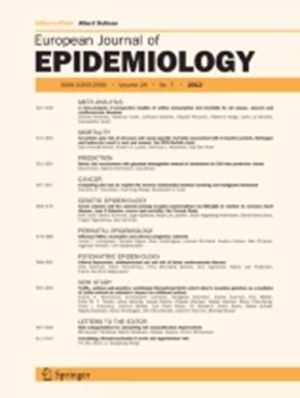口服避孕药可增加骨密度,降低患骨质疏松症的风险。
IF 5.9
1区 医学
Q1 PUBLIC, ENVIRONMENTAL & OCCUPATIONAL HEALTH
引用次数: 0
摘要
骨质疏松性骨折主要是由于绝经后雌激素水平降低和随后的骨质流失造成的,是老年妇女致残的主要原因。虽然口服避孕药(ocp)含有雌激素,但其对骨骼健康和骨质疏松风险的长期影响仍不确定。在这里,我们评估了OCP使用对骨密度(BMD)和骨质疏松症的影响,使用了来自英国生物银行(UK Biobank)的257,185名出生于1936-1970年的女性的数据。使用时间相关的Cox回归来估计骨质疏松症的校正风险比(hr)和95%置信区间(CI),而使用多变量线性回归来评估OCP使用对骨密度的影响,基于跟骨定量超声以标准差单位的t评分来衡量。到2020年随访结束时,7.6%的参与者被诊断为骨质疏松症。骨质疏松率在所有OCP使用者中较低(HR = 0.86;95% ci 0.83-0.89;p = 2.8 × 10-17)。使用OCP也与较高的BMD t评分相关(0.052;0.038 - -0.067;P = 2.1 × 10-12),使用时间越长,效果越好。使用ocp 0 ~ 1年对骨密度无显著影响(P = 0.081)。然而,与从未使用过的患者相比,持续时间较长与BMD t评分增加相关:2-5年(0.046;0.027-0.065, P = 2.2 × 10-6), 6-10年(0.062;0.043 - -0.080;P = 3.5 × 10-12), 11-15岁(0.062;0.042 - -0.081;P = 3.2 × 10-12)和16 +年(0.064;0.044 - -0.083;p = 1.2 × 10-10)。我们发现先前使用OCP与较高的骨密度和骨质疏松症风险降低有关,可能提供长期益处,并表明使用OCP可以减少老年妇女的骨质疏松症并发症。本文章由计算机程序翻译,如有差异,请以英文原文为准。
Oral contraceptive use increases bone density and reduces the risk of osteoporosis.
Osteoporotic fractures, largely resulting from reduced estrogen levels after menopause and subsequent bone loss, are a leading cause of disability among older women. Although oral contraceptive pills (OCPs) contain estrogen, their long-term impact on bone health and osteoporosis risk remain uncertain. Here, we assessed the effect of OCP use on bone mineral density (BMD) and osteoporosis using data from 257,185 women from the UK Biobank, born 1936-1970. Time-dependent Cox regression was used to estimate adjusted hazard ratios (HRs) and 95% confidence intervals (CI) for osteoporosis, while multivariable linear regression was used to assess the effect of OCP use on BMD, measured as T-scores in standard deviation units based on quantitative ultrasound of the calcaneus. By the end of follow-up in 2020, 7.6% of the participants had received an osteoporosis diagnosis. The rate of osteoporosis was lower among ever OCP users (HR = 0.86; 95% CI 0.83-0.89; P = 2.8 × 10-17). OCP use was also associated with a higher BMD T-score (0.052; 0.038-0.067; P = 2.1 × 10-12) with an increasing effect with longer use. Use of OCPs for 0-1 years had no significant effect on BMD (P = 0.081). However, longer durations were associated with increased BMD T-scores compared to never users: 2-5 years (0.046; 0.027-0.065, P = 2.2 × 10-6), 6-10 years (0.062; 0.043-0.080; P = 3.5 × 10-12), 11-15 years (0.062; 0.042-0.081; P = 3.2 × 10-12) and 16 + years (0.064; 0.044-0.083; P = 1.2 × 10-10). We found prior OCP use to be associated with higher BMD and a reduced risk of osteoporosis, potentially offering long-term benefits and suggesting that OCP use could reduce osteoporotic complications in older women.
求助全文
通过发布文献求助,成功后即可免费获取论文全文。
去求助
来源期刊

European Journal of Epidemiology
医学-公共卫生、环境卫生与职业卫生
CiteScore
21.40
自引率
1.50%
发文量
109
审稿时长
6-12 weeks
期刊介绍:
The European Journal of Epidemiology, established in 1985, is a peer-reviewed publication that provides a platform for discussions on epidemiology in its broadest sense. It covers various aspects of epidemiologic research and statistical methods. The journal facilitates communication between researchers, educators, and practitioners in epidemiology, including those in clinical and community medicine. Contributions from diverse fields such as public health, preventive medicine, clinical medicine, health economics, and computational biology and data science, in relation to health and disease, are encouraged. While accepting submissions from all over the world, the journal particularly emphasizes European topics relevant to epidemiology. The published articles consist of empirical research findings, developments in methodology, and opinion pieces.
 求助内容:
求助内容: 应助结果提醒方式:
应助结果提醒方式:


